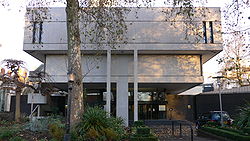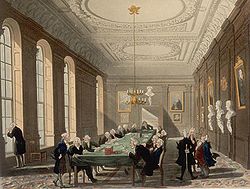- Royal College of Physicians
-
- Not to be confused with the Royal College of Physicians of Edinburgh or the Royal College of Physicians of Ireland.
The Royal College of Physicians of London was founded in 1518 as the College of Physicians (it acquired the "Royal" prefix in 1674) by royal charter of King Henry VIII in 1518 - the first medical institution in England to receive a royal charter. The college has been continuously active in improving practice medicine since then, primarily though training and qualifying new physicians. The current[update] president of the college is Sir Richard Thompson.
Contents
Post-nominals
The MRCP (UK) postnominals are obtained by doctors who have passed the Membership of the Royal College of Physicians examinations, held jointly with the other three Royal Colleges of Physicians in the UK and Ireland, through one of the UK colleges. Since the joint exam was originally set up with the other two UK colleges, the old qualification of MRCP (London) has continued to be awarded to a small number of people without examination. Holders of the MRCP (UK) are entitled to become "Collegiate Members" of this and/or the other two UK colleges. Both kinds of members may be considered for advancement to the fellowship.
Fellows (who use the postnominals FRCP) are elected mostly from the general Membership (MRCP), but also occasionally from among the members of the more specialised faculties within the Royal Colleges of Physicians, e.g., Occupational Medicine (MFOM), Pharmaceutical Medicine (MFPM), and Forensic and Legal Medicine (MFLM), etc. There are also Fellows who are elected de jure (usually medical experts from other countries), and honoris causa (dignitaries, members of the Royal Family, etc.).
The diploma of Licentiate of the Royal College of Physicians (LRCP) is no longer awarded. The LRCP qualification used to be reserved for medical graduates, in practice mainly Bachelors of Medicine from Oxford and Cambridge, but in the mid-nineteenth century became part of a very popular initial qualification in medicine awarded together with the MRCS (Eng) by the Conjoint Board which by the end of the twentieth century came to be largely taken by overseas graduates. From 1993 the LRCP was awarded together with the LRCS and LMSSA through the United Examining Board until this pathway to medical registration was abolished in 1999.
History
A small group of distinguished physicians, led by the scholar and humanist Thomas Linacre, petitioned the King to be incorporated into a College similar to those found in a number of other European countries. The main functions of the College, as set down in the founding Charter, were to grant licenses to those qualified to practice and to punish unqualified practitioners and those engaging in malpractice. This included apothecaries as well as physicians.
The College was based at Amen Corner near St Paul's Cathedral, until it was burnt down in the Great Fire of London of 1666. The first Harveian Librarian was Christopher Merret.
Throughout its history the College has issued advice across the whole range of medical and health matters. College publications include the first ten editions of the London Pharmacopoeia (written in Latin, and used for regulating the composition of medicines from 1618 and, through the College's police the Censors, for enforcing the College's monopoly on medical science, then being challenged by the Society of Apothecaries), and the `Nomenclature of Diseases' in 1869. The latter created the international standard for the classification of diseases which was to last until the World Health Organisation's Manual of the international classification of diseases superseded it in the twentieth century.
The College became the licensing body for medical books in the late seventeenth century, and sought to set new standards in learning through its own system of examinations. The College's great tradition of examining continues to this day and it is still perhaps how the College is best known to the general public.
Collections of the Royal College of Physicians
The collections at the Royal College of Physicians relate to the history of the College, and the history of the Physician’s profession. They help to place the history and development of medicine and health care in its widest context. The collections include; portraits, silver, medical instruments, the Symons Collection, commemorative medals and anatomical tables. Each individual item has a story to tell and can provide insights into a continual movement for the advancement of healthcare.
The collection of c. 250 portraits provides a pictorial and sculptural record of Presidents, Fellows and other physicians associated with it from its foundation in 1518 to the present day. It includes some outstanding pieces by well-known artists, such as a bust of Baldwin Hamey Junior (1600–1676) by Edward Pierce and one of Richard Mead (1673–1754) by Louis François Roubiliac. But perhaps of more interest are the portraits by lesser-known artists, revealing their best talents, such as Richard Hale (1670–1728) by Jonathan Richardson.
The silver collection reflects events in the College’s history as well as the lives and generosity of its Fellows and Members. Few pieces pre-date the Great Fire of London (1666) because of a robbery during the previous year. Baldwin Hamey’s inkstand bell and William Harvey's demonstration rod are two of the pieces that survive. Many pieces of silver are ‘working’ objects and are used to this day for formal occasions in the College. Special objects include the President’s staff of office, the caduceus and the silver-gilt College mace.
The College also owns six 17th century anatomical tables, probably made by drying and mounting the actual blood vessels and nerves of the human body onto blocks of wood and then varnishing them. They would have been used as a teaching aid for teaching anatomy, because it was difficult to obtain cadavers for dissection.
The Symons Collection of medical instruments is well displayed within the College building. The collection began as a collection of objects relating to self-care in Georgian times and expanded to include items that would have been used by physicians when treating patients, mostly in the eighteenth and nineteenth centuries.
The collections are open to the general public Monday to Friday 9am - 5pm. The Royal College of Physicians is a member of the London Museums of Health & Medicine.
Facility
The College's former headquarters on Trafalgar Square is now Canada House, part of the Canadian high commission in London.
The College is now located in St. Andrews Place, which is at the north end of the road running up the east side of Regent's Park, Park Square East. The College building itself is notable. It was designed by architect Sir Denys Lasdun in 1964 and has since been recognised as a building of national importance: it is a Grade I listed building, one of a very select band of post-war buildings sharing this distinction. Lasdun's use of mosaic clad concrete was extremely influential on many later public buildings. An interesting feature of the building was a 'Moving Wall', weighing five tons (5080 kg) and capable of being hydraulically lifted ten feet (3050 mm) to unite or sub-divide a hall of sixty-two feet (18.9 m) width, which was the interior width of the building. The hydraulic equipment and the steel framework for the Moving Wall were produced by Merryweather & Sons Ltd of Greenwich, hydraulic engineers. Although better known for fire fighting equipment it was not the company's first installation of this kind. Technical details of the Moving Wall can be found in Engineering journal, 1 Jan. 1965.
Publications
Clinical Medicine is the College's own medical journal. It appears once every two months. In addition, the college publishes regular reports, clinical guidelines, and the annual series 'Horizons in Medicine'. Their 'Faculty of Occupational Medicine' publishes 'Occupational and Environmental Medicine', a monthly-published journal that contains studies and articles concerting topics related to human health and environmental topics.
Training Faculties
Faculty of Pharmaceutical Medicine[1]
The Faculty of Pharmaceutical Medicine (FPM) of the Royal Colleges’ of Physicians aims to maintain the highest professional standards in the specialty through activities such as the setting of the Diploma in Pharmaceutical Medicine and other examinations and supervising specialty training in pharmaceutical medicine.
Faculty of Occupational Medicine[2]
The Faculty of Occupational Medicine (FOM) was established to develop and maintain high standards of training and professional integrity in the specialty of occupational medicine. It sets exams, supervises training and supports physicians in their continued professional development. The Faculty also acts as an authoritative body for consultation in matters of education and public interest concerning occupational medicine
College lectures
The College holds an annual lecture, commonly referred to as the Lumleian Lectures, which were named in honour of Lord Lumley and established as part of the Lumleian Trust. The trust and lectures were established in 1582 by Dr. Richard Caldwell, a former president of the college. The subject matter of the lectures was initially in surgery, which was later changed to in medicine.[3] The first lecture was given by Richard Forster, and the lectures continue to today.
Other annual lectures are the Croonian Lecture, the Goulstonian Lecture and the Bradshaw Lecture.
Once a year, traditionally on St Lukes Day, a Fellow is appointed to deliver the Harveian Oration to the assembled college in memory of William Harvey. The oration seeks to honour the founders and benefactors of the college and encourage a spirit of experimentation amongst the members.
Past presidents
See List of Presidents of the Royal College of Physicians
Notable Alumni
- Dr. Abdul Malik (professor), cardiologist and National Professor of Bangladesh.
See also
References
- ^ "Faculty of Pharmaceutical Medicine". NHS. http://www.medicalcareers.nhs.uk/tools_and_resources/spotlight_on_royal_colleges/faculty_of_pharmaceutical_medi.aspx. Retrieved 20 August 2010.
- ^ "Faculty of Occupational Medicine". NHS. http://www.medicalcareers.nhs.uk/tools_and_resources/spotlight_on_royal_colleges/faculty_of_occupational_med.aspx. Retrieved 20 August 2010.
- ^ "Heritage Centre : College Lectures". Royal College of Physicians. http://www.rcplondon.ac.uk/heritage/CollegeLectures/Lumleian.htm. Retrieved 2008-08-03.
Further reading
- Dodds, C. (1954) Christopher Merrett, F.R.C.P. (1614–1695), First Harveian Librarian Proc R Soc Med. 1954 December; 47(12): 1053–1056. Old but detailed account of Merrett's time at the College, from the creation of the library to the Great Fire of London.
External links
- Official website RCPLONDON
- Official website MRCPUK
- Notes on the Royal College of Physicians from the Scholarly Societies project (includes information on the journals of the society)
Coordinates: 51°31′32.83″N 00°08′41.89″W / 51.5257861°N 0.1449694°W
Categories:- Royal College of Physicians
- Grade I listed buildings in London
- Medical associations based in the United Kingdom
- Healthcare in the United Kingdom
- Professional associations based in the United Kingdom
- Royal Colleges
- 1518 establishments in England
- Denys Lasdun buildings
- Buildings and structures in Camden
- Grade I listed institutional headquarters
- Organisations based in London with royal patronage
- Medical museums in the United Kingdom
- Museums in Camden
Wikimedia Foundation. 2010.


